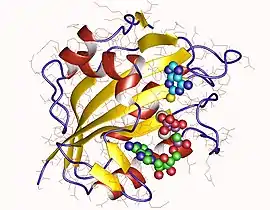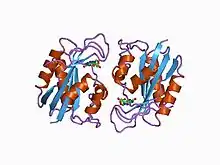| 2-amino-4-hydroxy-6-hydroxymethyldihydropteridine diphosphokinase | |||||||||
|---|---|---|---|---|---|---|---|---|---|
 2-amino-4-hydroxy-6-hydroxymethyldihydropteridine diphosphokinase monomer, E.Coli | |||||||||
| Identifiers | |||||||||
| EC no. | 2.7.6.3 | ||||||||
| CAS no. | 37278-23-2 | ||||||||
| Databases | |||||||||
| IntEnz | IntEnz view | ||||||||
| BRENDA | BRENDA entry | ||||||||
| ExPASy | NiceZyme view | ||||||||
| KEGG | KEGG entry | ||||||||
| MetaCyc | metabolic pathway | ||||||||
| PRIAM | profile | ||||||||
| PDB structures | RCSB PDB PDBe PDBsum | ||||||||
| Gene Ontology | AmiGO / QuickGO | ||||||||
| |||||||||
| 7,8-dihydro-6-hydroxymethylpterin-pyrophosphokinase (HPPK) | |||||||||
|---|---|---|---|---|---|---|---|---|---|
 7,8-dihydro-6-hydroxymethylpterin-pyrophosphokinase from haemophilus influenzae | |||||||||
| Identifiers | |||||||||
| Symbol | HPPK | ||||||||
| Pfam | PF01288 | ||||||||
| InterPro | IPR000550 | ||||||||
| PROSITE | PDOC00631 | ||||||||
| SCOP2 | 1hka / SCOPe / SUPFAM | ||||||||
| CDD | cd00483 | ||||||||
| |||||||||
In enzymology, a 2-amino-4-hydroxy-6-hydroxymethyldihydropteridine diphosphokinase (EC 2.7.6.3) is an enzyme that catalyzes the chemical reaction
- ATP + 2-amino-4-hydroxy-6-hydroxymethyl-7,8-dihydropteridine AMP + (2-amino-4-hydroxy-7,8-dihydropteridin-6-yl)methyl diphosphate
Thus, the two substrates of this enzyme are ATP and 2-amino-4-hydroxy-6-hydroxymethyl-7,8-dihydropteridine, whereas its two products are AMP and (2-amino-4-hydroxy-7,8-dihydropteridin-6-yl)methyl diphosphate.
This enzyme belongs to the family of transferases, specifically those transferring two phosphorus-containing groups (diphosphotransferases). The systematic name of this enzyme class is ATP:2-amino-4-hydroxy-6-hydroxymethyl-7,8-dihydropteridine 6'-diphosphotransferase. Other names in common use include 2-amino-4-hydroxy-6-hydroxymethyldihydropteridine pyrophosphokinase, H2-pteridine-CH2OH pyrophosphokinase, 7,8-dihydroxymethylpterin-pyrophosphokinase, HPPK, 7,8-dihydro-6-hydroxymethylpterin pyrophosphokinase, and hydroxymethyldihydropteridine pyrophosphokinase. This enzyme participates in folate biosynthesis.
This enzyme catalyses the first step in a three-step pathway leading to 7,8 dihydrofolate. Bacterial HPPK (gene folK or sulD) is a protein of 160 to 270 amino acids.[1] In the lower eukaryote Pneumocystis carinii, HPPK is the central domain of a multifunctional folate synthesis enzyme (gene fas).[2]
Structural studies
As of late 2007, 23 structures have been solved for this class of enzymes, with PDB accession codes 1DY3, 1EQ0, 1EQM, 1EX8, 1F9H, 1F9Y, 1G4C, 1HKA, 1HQ2, 1IM6, 1KBR, 1Q0N, 1RAO, 1RB0, 1RTZ, 1RU1, 1RU2, 1TMJ, 1TMM, 2BMB, 2CG8, 2F63, and 2F65.
References
- ↑ Talarico TL, Ray PH, Dev IK, Merrill BM, Dallas WS (September 1992). "Cloning, sequence analysis, and overexpression of Escherichia coli folK, the gene coding for 7,8-dihydro-6-hydroxymethylpterin-pyrophosphokinase". J. Bacteriol. 174 (18): 5971–7. doi:10.1128/jb.174.18.5971-5977.1992. PMC 207135. PMID 1325970.
- ↑ Volpe F, Dyer M, Scaife JG, Darby G, Stammers DK, Delves CJ (March 1992). "The multifunctional folic acid synthesis fas gene of Pneumocystis carinii appears to encode dihydropteroate synthase and hydroxymethyldihydropterin pyrophosphokinase". Gene. 112 (2): 213–8. doi:10.1016/0378-1119(92)90378-3. PMID 1313386.
Further reading
- Richey DP, Brown GM (1969). "The biosynthesis of folic acid. IX. Purification and properties of the enzymes required for the formation of dihydropteroic acid". J. Biol. Chem. 244 (6): 1582–92. PMID 4304228.
- Richey DP, Brown GM (1971). "Hydroxymethyldihydropteridine pyrophosphokinase and dihydropteroate synthetase from Escherichia coli". Methods Enzymol. 18B: 765–771. doi:10.1016/s0076-6879(71)18150-5.
- Shiota T, Baugh CM, Jackson R, Dillard R (1969). "The enzymatic synthesis of hydroxymethyldihydropteridine pyrophosphate and dihydrofolate". Biochemistry. 8 (12): 5022–8. doi:10.1021/bi00840a052. PMID 4312465.